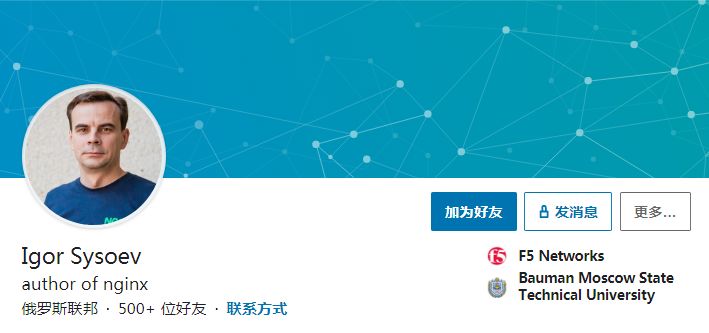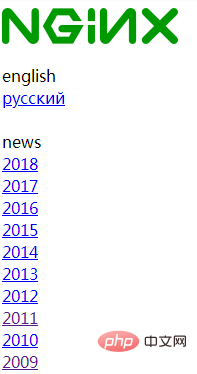Nginx (pronounced Engine x) is a high-performance HTTP and reverse proxy web server that also integrates IMAP/POP3/SMTP services. It is a star project with over 10,000 stars on Github (Github address: https://github.com/nginx/nginx).
Nginx is a project originally created by Igor Sysoev. According to ZDNet, Russian police raided NGINX on December 12 and took away NGINX founders Igor Sysoev and Maxim Konovalov.

At present, Nginx has actually replaced Apache HTTPD and become the most widely deployed service project on the Internet. According to the latest survey, Nginx's market share in web servers is as high as 38%. Almost all well-known domestic companies such as Baidu, JD.com, Sina, NetEase, Tencent, and Alibaba are using Nginx.
Litigation from the old club
A week ago, Igor Sysoev’s former employer Rambler Group filed a copyright infringement lawsuit against Nginx, claiming that Igor All the development results of Sysoe during his tenure belong to the Rambler Group, so the company is the legal owner of the Nginx project.
The author is not sure how Sysoev signed the agreement with his former employer, but according to public information, Sysoev built Nginx in the early 2000s and opened the source code in 2004. In 2009, he established the Nginx company in the United States, and then resigned from the original company in 2011. He also served as the CTO of Nginx company, promoting the enhanced version of Nginx to enterprise users. Sysoev's departure from the original company two years after Nginx was founded is likely to be the trigger that provoked the Rambler Group to file a lawsuit.
Of course, the underlying reason for this incident should still be interests. We saw that earlier this year, Nginx was acquired by F5 for a sky-high price of US$670 million. It is probably this news that made Rambler Group aware of It turned out that the F5 created by Sysoev actually contained such high value that he sued in anger.
Old club VS former employee, based on geometry
Regarding this copyright dispute, the author specifically consulted colleagues from the Legal Security Department. We found that financial institutions and IT companies are A completely opposite attitude towards employee behavior in their spare time. Because if financial practitioners use their business to promote other products to customers, it is likely to bring risks to their units. Therefore, you can see that many banks, trusts, securities and other institutions often clearly separate themselves from employees' amateur activities to avoid damaging their own reputations. The main goal of IT companies is to obtain the support of all employees' brain power, so they tend to possess the copyright of employees' spare time creations. To clarify the ownership of software created by employees in their spare time, there are three laws and one legal principle that need to be considered.
The first is the "Patent Law Implementing Rules". Since the "Patent Law" is the basic legal framework for protecting intellectual property rights and is in line with international law, it is the first factor to be considered. The specific provisions are as follows:
Inventions and creations completed under the following circumstances are all service inventions and creations.
(1) Inventions and creations completed by the inventor in the course of his or her job;
(2) Inventions and creations completed by the inventor while performing tasks assigned by the unit that are outside (and unrelated to) his or her job. ;
(3) Inventions and creations completed mainly by utilizing the material conditions of the unit (including capital equipment, parts, raw materials or technical data not disclosed to the outside world, etc.);
(4) Inventions and creations made within one year of retiring, retiring or being transferred that are related to their own work or assigned tasks in the original unit.
The second is the Copyright Law, which stipulates as follows:
For professional works that fall under any of the following circumstances, the author enjoys the right of signature, and other rights of copyright are enjoyed by legal persons or other organizations. Legal persons or Other organizations may award the author:
(1) Engineering design drawings, product design drawings, maps, and computer software that are mainly created using the material and technical conditions of a legal person or other organization, and for which the legal person or other organization is responsible. and other professional works;
(2) Professional works for which the copyright is enjoyed by legal persons or other organizations as stipulated in laws, administrative regulations or contracts.
The "Computer Software Protection Regulations", a subordinate law of the "Copyright Law", stipulates as follows:
The software developed by a natural person while serving in a legal person or other organization falls under any of the following circumstances: , the software copyright is enjoyed by the legal person or other organization, and the legal person or other organization can reward the natural person who develops the software:
(1) Software developed for the development goals clearly specified in the job;
(2) The software developed is the foreseeable or natural result of engaging in work activities;
(3) The funds, special equipment, and undisclosed resources of legal persons or other organizations are mainly used. Software developed with specialized information and other material and technical conditions and borne by legal persons or other organizations.
There is also an important legal principle of equality of rights and responsibilities that is relatively beneficial to programmers. For example, if legal software created by employees in their spare time is considered professional behavior, then if illegal software is written in their spare time, will the company bear responsibility? . This is also something to consider.
Will the father of Nginx face jail time
According to the current situation, the lawsuit against Sysoev is to accuse him of illegally open source software that originally belonged to his former employer , thereby infringing the copyright of the Rambler Group. Judging from the current situation, the most unfavorable situation for Sysoev may be that Nginx was established in 2009, and he himself was in He only resigned in 2011 (the author has not found authoritative information about the time of resignation and needs to confirm it), and if this is true, then the former employer is very likely to accuse Sysoev of using working time to serve Nginx.
The favorable factor is the limitation on the retroactive period of property rights. According to data, the current retrospective period for copyright in Russia is also two years. In 2012, Sysoev publicly stated that Nginx was created in his spare time. However, the former employer has never been held accountable, so this is very beneficial to the IT master. 
How Programmers Cope Whether the product was created using working time
(2) Whether the company’s funds, equipment and undisclosed information were used
(3) If it is related to the job, whether the employee resigned or transferred after a full year YearsSo if readers use their spare time to write code and hope to own the copyright, then they must pay attention to the following points
(1) Do not write code for your own projects during working hours Code, of course, this is just talking about it. I don’t think many programmers are that easy.
(2) Do not use the company’s computer for programming, especially do not use the WIFI provided by the company to check the ISSUE or ISSUE of your project on Github. Submit a PR. These inadvertent actions may give companies an excuse to file a dispute.
(3) If it is a project related to your job, try to do it one year after leaving your job.
This article is reproduced from the original article of CSDN blogger "beyondma".
Related recommendations:
1.Nginx usage tutorial
2.Apache usage tutorial